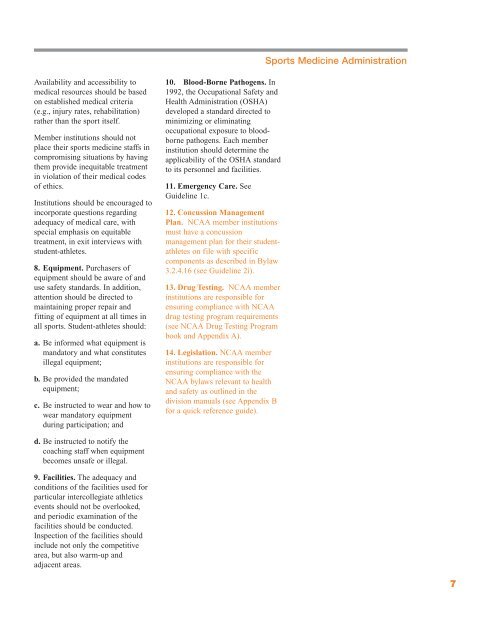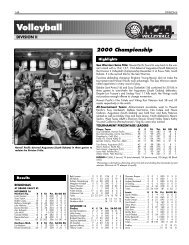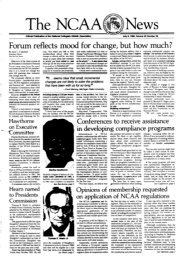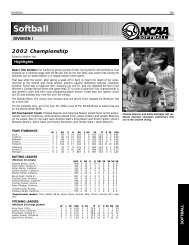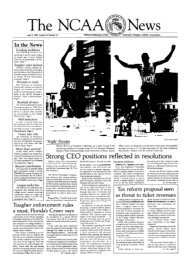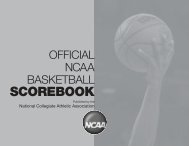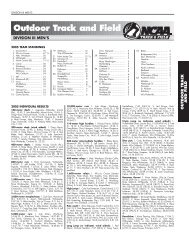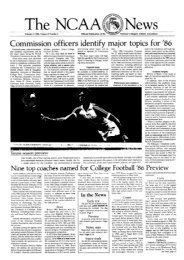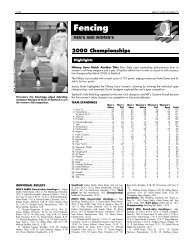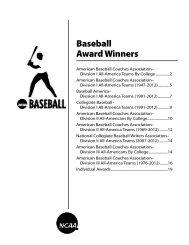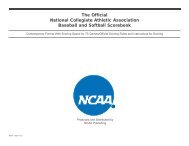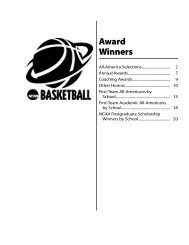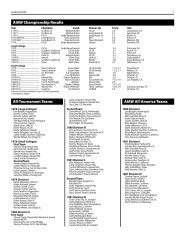Sports Medicine Handbook - NCAA
Sports Medicine Handbook - NCAA
Sports Medicine Handbook - NCAA
You also want an ePaper? Increase the reach of your titles
YUMPU automatically turns print PDFs into web optimized ePapers that Google loves.
Availability and accessibility to<br />
medical resources should be based<br />
on established medical criteria<br />
(e.g., injury rates, rehabilitation)<br />
rather than the sport itself.<br />
Member institutions should not<br />
place their sports medicine staffs in<br />
compromising situations by having<br />
them provide inequitable treatment<br />
in violation of their medical codes<br />
of ethics.<br />
Institutions should be encouraged to<br />
incorporate questions regarding<br />
adequacy of medical care, with<br />
special emphasis on equitable<br />
treatment, in exit interviews with<br />
student-athletes.<br />
8. Equipment. Purchasers of<br />
equipment should be aware of and<br />
use safety standards. In addition,<br />
attention should be directed to<br />
maintaining proper repair and<br />
fitting of equipment at all times in<br />
all sports. Student-athletes should:<br />
a. Be informed what equipment is<br />
mandatory and what constitutes<br />
illegal equipment;<br />
b. Be provided the mandated<br />
equipment;<br />
c. Be instructed to wear and how to<br />
wear mandatory equipment<br />
during participation; and<br />
d. Be instructed to notify the<br />
coaching staff when equipment<br />
becomes unsafe or illegal.<br />
9. Facilities. The adequacy and<br />
conditions of the facilities used for<br />
particular intercollegiate athletics<br />
events should not be overlooked,<br />
and periodic examination of the<br />
facilities should be conducted.<br />
Inspection of the facilities should<br />
include not only the competitive<br />
area, but also warm-up and<br />
adjacent areas.<br />
10. Blood-Borne Pathogens. In<br />
1992, the Occupational Safety and<br />
Health Administration (OSHA)<br />
developed a standard directed to<br />
minimizing or eliminating<br />
occupational exposure to bloodborne<br />
pathogens. Each member<br />
institution should determine the<br />
applicability of the OSHA standard<br />
to its personnel and facilities.<br />
11. Emergency Care. See<br />
Guideline 1c.<br />
12. Concussion Management<br />
Plan. <strong>NCAA</strong> member institutions<br />
must have a concussion<br />
management plan for their studentathletes<br />
on file with specific<br />
components as described in Bylaw<br />
3.2.4.16 (see Guideline 2i).<br />
13. Drug Testing. <strong>NCAA</strong> member<br />
institutions are responsible for<br />
ensuring compliance with <strong>NCAA</strong><br />
drug testing program requirements<br />
(see <strong>NCAA</strong> Drug Testing Program<br />
book and Appendix A).<br />
14. Legislation. <strong>NCAA</strong> member<br />
institutions are responsible for<br />
ensuring compliance with the<br />
<strong>NCAA</strong> bylaws relevant to health<br />
and safety as outlined in the<br />
division manuals (see Appendix B<br />
for a quick reference guide).<br />
<strong>Sports</strong> <strong>Medicine</strong> Administration<br />
7


